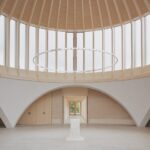Gulbenkian Prize Architects, Architecture, Buildings, Projects, News, Design
Gulbenkian Prize Awards for Architecture
Shortlist / Winners for 2007
Gulbenkian Prize
Gulbenkian Museum Prize 2007 : Pallant House, Chichester, Sussex
by the late Sandy Wilson
Gulbenkian Museum Prize : Pallant House
The Gulbenkian Prize for museums and galleries
Shortlist announced 2 Feb – £100,000 prize
Gulbenkian Prize Shortlist, 2007
Braintree District Museum for the Warner Textile Archive, Essex
De La Warr Pavilion for its re-launch, Bexhill-on-sea, East Sussex
Horniman Museum for their new Aquarium, London
Kelvingrove Art Gallery & Museum for their New Century Project, Glasgow
Kew Palace, Historic Royal Palaces, Surrey
Pallant House Gallery, Chichester, West Sussex
Scotland & Medicine: Collections & Connections, Scotland
V&A for The Jameel Gallery of Islamic Art, London
Weston Park Museum, Sheffield
The Women’s Library for the exhibition, ‘Prostitution: What’s Going On?’ London
Metropolitan University, London
The four short-listed museums for the 2007 prize announced early April
Winner announcement: 24 May at Royal Institute of British Architects, London
Gulbenkian Prize Past Winners
Gulbenkian Prize – 2006: Brunel’s SS Great Britain, Bristol
Gulbenkian Prize – 2005: Big Pit: National Mining Museum of Wales, Blaenafon
Gulbenkian Prize – 2004: Scottish Gallery of Modern Art – Landform – by Charles Jencks
Gulbenkian Prize Shortlist : De La Warr Pavilion
Gulbenkian Prize Shortlist : Kelvingrove Art Gallery & Museum
Gulbenkian Prize 2007
4 Apr 2007
Short list announced for £100,000 Gulbenkian Prize for museums and galleries
Britain’s smallest royal palace; the first UK art gallery to cut its carbon emissions by almost 50%; and two transformed Victorian treasure houses are the four short-listed projects competing for this year’s Gulbenkian Prize for museums and galleries.
The short list was chosen from a long list of ten museum and gallery projects, which included the V&A’s Jameel Gallery of Islamic Art, London and the newly restored De La Warr Pavilion, East Sussex. The winner of the £100,000 Prize will be announced on 24 May at RIBA, London. The short list of four is as follows:
Kelvingrove Art Gallery & Museum, Glasgow for its New Century Project
A bold three-year £35m restoration and re-display of Glasgow’s world-famous Victorian art gallery and museum. Described as “one of the greatest civic collections in Europe”, and now with some 8,500 objects on display, visitors can explore collections ranging from fine and decorative arts to archaeology and the natural world. With the priority of appealing to a wide range of audiences, a radical new approach – seen by some as controversial – has been taken to the presentation of these diverse collections, cutting across disciplines and communicating through themes and stories.
Kew Palace, Historic Royal Palaces, London
Visitors to Britain’s smallest royal palace step straight into the world of the early 1800s when Kew was inhabited by George III and his large family. Whilst some of the palace has been re-created in vivid Georgian splendour – in often startling but authentic colour-schemes – the upper floors remain untouched, revealing rooms unseen by the public for 200 years. A carefully understated approach to conservation and interpretation, and the use of imaginative visual and sound effects, provide the visitor with fresh insights into a story of domestic intimacy, and a tragic final illness.
Pallant House Gallery, Chichester, West Sussex
Pallant House Gallery is home to one of the best collections of Modern British art in the world, including works by Blake, Bomberg, Caulfield, Nicholson, Piper, Sickert and Sutherland. Its new £8.6m extension, designed by Long and Kentish in association with Professor Sir Colin St John Wilson, integrates contemporary design with the original Grade I listed Queen Anne townhouse. Seventeen galleries now allow the permanent collections and temporary exhibitions to be shown to their best advantage. This is the first gallery in the UK to install a geothermal heating and cooling system, cutting its carbon emissions by 40-50%.
Weston Park Museum, Sheffield Galleries & Museums Trust, Sheffield
A £19m transformation to create an accessible, welcoming and vibrant place of culture and learning, created with the help of the local community. Weston Park Museum houses treasures that range from Egyptian mummies to a traditional butcher’s shop. Fascinating histories and hands-on inter-actives bring to life the unusual treasures from Sheffield’s archaeology, natural and social history and visual and decorative art collections. It attracted 55,000 visitors in the first
15 days of opening.
Chair of the judges, Francine Stock, comments:
‘Choosing a shortlist has been tough. We’ve travelled coast to coast from northernmost Scotland to the Sussex seaside visiting ten very different museums. Each has its own way of attracting the local community and new audiences to collections and exhibitions, and it’s exciting to see the growth in visitor numbers. There are marked contrasts in size and style but all four shortlisted museums are outstanding.’
The Gulbenkian Prize is the UK’s biggest single arts prize at £100,000. It is given annually to one museum or gallery, large or small, anywhere in the UK for excellence and innovation, regardless of its size or budget. The winner will be announced during Museums and Galleries Month on Thursday, 24 May at the Royal Institution of British Architects, London.
The main sponsor of The Gulbenkian Prize for museums and galleries is the Calouste Gulbenkian Foundation, for 50 years a pioneering funder of developments in contemporary arts, education and social change in the United Kingdom and Republic of Ireland and a leading agency in the promotion of Portuguese culture. The Prize is also supported by The Museums, Libraries and Archives Council (MLA), the national development agency working for and on behalf of museums, libraries and archives and advising government on policy and priorities for the sector.
Each of the four on the short list has received funding from the Heritage Lottery Fund (HLF), demonstrating how lottery funding is central to transforming the UK’s museums and galleries.
Dame Liz Forgan, Chair of the Heritage Lottery Fund, comments:
‘The Gulbenkian Prize is a by-word for excellence and innovation in museums and galleries across the UK and the Heritage Lottery Fund is extremely proud to have funded all four of the 2007 finalists. This is a fascinating and eclectic group of nominees ranging from an exquisite 18th-century Royal palace to a Queen Anne town house with a fine contemporary collection. Each one is fully deserving of their position on this short-list and I wish them all luck for the final decision.’
Last year’s winner was Brunel’s ss Great Britain in Bristol, whose visitor figures have since increased by 40%. Brunel’s ss Great Britain has just been short-listed for the European Museum of the Year award. The winner of the first Gulbenkian Prize was the National Centre for Citizenship and the Law at the Galleries of Justice in Nottingham. In 2004, the Scottish Gallery of Modern Art won the Gulbenkian Prize for Landform – part sculpture, part garden, part land-art – by Charles Jencks, to be followed by Big Pit: National Mining Museum of Wales, Blaenafon, in 2005.
Naturally as soon as the Gulbenkian Prize Winner is announced for 2007 we will aim to post it online here right away, thanks for your visit to e-architect.com
Gulbenkian Prize Longlist
The Gulbenkian Prize short list was chosen from a long list of ten:
Braintree District Museum for the Warner Textile Archive, Essex
De La Warr Pavilion for its re-launch, Bexhill-on-Sea, East Sussex
Horniman Museum for their new Aquarium, London,
Kelvingrove Art Gallery & Museum for their New Century Project, Glasgow
Kew Palace, Historic Royal Palaces, Surrey
Pallant House Gallery, Chichester, West Sussex
Weston Park Museum, Sheffield
Scotland & Medicine: Collections & Connections, Scotland
V&A for The Jameel Gallery of Islamic Art, London,
The Women’s Library for the exhibition, ‘Prostitution: What’s Going On?’, London Metropolitan University
The 2007 judging panel represents a wide range of artistic, scientific and academic interests and museum experience. With author and broadcaster Francine Stock as chair, it comprises:
Tristram Besterman – museum consultant, former director of Manchester Museum
Richard Calvocoressi – Director of the Scottish National Gallery of Modern Art in Edinburgh, Director-elect of the Henry Moore Foundation
Dr Mark Miodownik – materials scientist, head of the Materials Research Group at King’s College London, Director of the Materials Library
Joanna Moorhead – journalist and author
Dan Snow – historian and broadcaster
Mohini Sule – cultural broadcaster for programmes including BBC Culture Show and The People’s Museum
Paula Ridley, who is both Director of the Calouste Gulbenkian Foundation UK Branch and Chairman of the V&A, took no part in assessing applications for the Prize at any stage of the process.
The Gulbenkian Prize for museums and galleries is funded by the Calouste Gulbenkian Foundation, whose Headquarters are in Lisbon. For 50 years the Foundation’s UK Branch has been a pioneering funder of developments in contemporary arts, education and social change in the United Kingdom and Republic of Ireland and a leading agency in the promotion of Portuguese culture. The Arts Programme has traditionally played an active role in encouraging artists and arts organisations, including museums, to find original and inventive ways of developing their practice.
Calouste Sarkis Gulbenkian was an Armenian, who became a British citizen and conducted his business in London before finally settling in Portugal. His distinguished private collection of art and artefacts is housed in the Calouste Gulbenkian Museum in Lisbon, which is recognised as one of the best small museums in Europe. The tradition of collecting has been continued by the Foundation and the holdings of its Modern Art Centre include an extensive collection of modern British artworks.
The Gulbenkian Prize for museums and galleries is administered by the Museum Prize, a charitable company created in 2002 by The Art Fund, the Campaign for Museums, the Museums Association, and National Heritage.
The Prize is supported by The Museums, Libraries and Archives Council (MLA), the national development agency working for and on behalf of museums, libraries and archives and advising government on policy and priorities for the sector.
The Heritage Lottery Fund has funded four museums and galleries on the short list for the Gulbenkian Prize this year. £33.2 million went specifically to the elements of the projects that are short listed for this prestigious arts prize. The HLF enables communities to celebrate, look after and learn more about our diverse heritage. From our great museums and historic buildings to local parks and beauty spots or recording and celebrating traditions, customs and history, HLF grants open up our nation’s heritage for everyone to enjoy. Over the last 12 years, it has supported more than 22,500 projects, allocating over £3.6billion across the UK, £1.2billion of which has been awarded to museums and galleries.
Location:UK
Pritzker Prize Winner 2007: Richard Rogers
Key European Architecture Award:
Stirling Prize
Architecture Awards
RIBA Awards
Dynamic Place Awards
Pritzker Prize Winner 2004 : Zaha Hadid
Comments / photos for the Gulbenkian Prize Architects page welcome
Gulbenkian Prize : page
Website: www.thegulbenkianprize.org.uk




